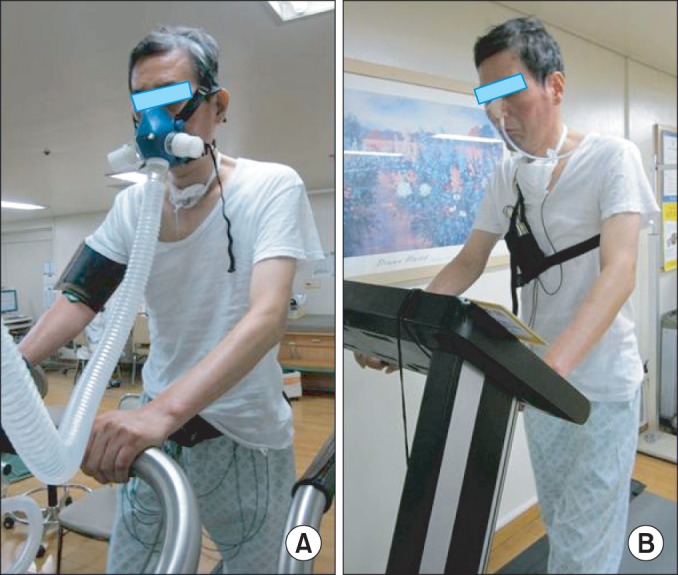Ann Rehabil Med.
2014 Aug;38(4):554-558. 10.5535/arm.2014.38.4.554.
Cardiac Rehabilitation of a Patient With an Advanced Dilated Cardiomyopathy: A Case Report
- Affiliations
-
- 1Department of Rehabilitation Medicine, Inje University Sanggye Paik Hospital, Inje University College of Medicine, Seoul, Korea. s3163@paik.ac.kr
- KMID: 2165739
- DOI: http://doi.org/10.5535/arm.2014.38.4.554
Abstract
- The dilated cardiomyopathy is the common type of cardiomyopathy, and its distinctive characteristic is the systolic dysfunction. Not many reports were issued about the efficacy of cardiac rehabilitation in patients with an advanced dilated cardiomyopathy until yet. A 50-year-old man who was diagnosed with dilated cardiomyopathy with congestive heart failure was admitted to the emergency room after a sudden collapse and a ventricular fibrillation was presented in the actual electrocardiogram. After three months, the patient participated in an 8-week cardiac rehabilitation program with electrocardiogram monitoring for 50 minutes per session at five times per week. The maximal oxygen consumption improved from 13.5 to 19.4 mL/kg/min during this time. At 3.9 metabolic equivalents, the myocardial oxygen demand decreased from 21,710 to 12,669 mmHg.bpm and the Borg's scale of perceived exertion decreased from 15 to 9. The left ventricular ejection fraction improved from 14% to 19%. So in this case report will be presented a patient after a successful cardiac rehabilitation program. Before this the patient suffered from a much more advanced dilated cardiomyopathy and was resuscitated from cardiac arrest.
Keyword
MeSH Terms
Figure
Reference
-
1. Schoen F. The heart. In : Kumar V, Abbas AK, Fausto N, editors. Robbins and Cotran pathological basis of disease. 7th ed. Philadelphia: Elsevier;2005. p. 555–618.2. Luk A, Ahn E, Soor GS, Butany J. Dilated cardiomyopathy: a review. J Clin Pathol. 2009; 62:219–225. PMID: 19017683.
Article3. Grogan M, Redfield MM, Bailey KR, Reeder GS, Gersh BJ, Edwards WD, et al. Long-term outcome of patients with biopsy-proved myocarditis: comparison with idiopathic dilated cardiomyopathy. J Am Coll Cardiol. 1995; 26:80–84. PMID: 7797779.
Article4. Stolen KQ, Kemppainen J, Ukkonen H, Kalliokoski KK, Luotolahti M, Lehikoinen P, et al. Exercise training improves biventricular oxidative metabolism and left ventricular efficiency in patients with dilated cardiomyopathy. J Am Coll Cardiol. 2003; 41:460–467. PMID: 12575976.
Article5. Belardinelli R, Georgiou D, Cianci G, Purcaro A. Randomized, controlled trial of long-term moderate exercise training in chronic heart failure: effects on functional capacity, quality of life, and clinical outcome. Circulation. 1999; 99:1173–1182. PMID: 10069785.
Article6. O'Connor CM, Whellan DJ, Lee KL, Keteyian SJ, Cooper LS, Ellis SJ, et al. Efficacy and safety of exercise training in patients with chronic heart failure: HFACTION randomized controlled trial. JAMA. 2009; 301:1439–1450. PMID: 19351941.7. Holloway CJ, Dass S, Suttie JJ, Rider OJ, Cox P, Cochlin LE, et al. Exercise training in dilated cardiomyopathy improves rest and stress cardiac function without changes in cardiac high energy phosphate metabolism. Heart. 2012; 98:1083–1090. PMID: 22739638.
Article8. Abraham WT, Fisher WG, Smith AL, Delurgio DB, Leon AR, Loh E, et al. Multicenter InSync Randomized Clinical Evaluation: cardiac resynchronization in chronic heart failure. N Engl J Med. 2002; 346:1845–1853. PMID: 12063368.
- Full Text Links
- Actions
-
Cited
- CITED
-
- Close
- Share
- Similar articles
-
- Maternally Inherited Familial Hypertrophic Cardiomyopathy Manifested by Pregnancy Related Early Progression and Sudden Cardiac Death
- Correction: Cardiac Rehabilitation of a Patient With an Advanced Dilated Cardiomyopathy: A Case Report
- Dilated Cardiomyopathy Associated with Clozapine
- Dilated Cardiomyopathy in Acromegaly: a Case Report with Cardiac MR Findings
- Combined spinal-epidural analgesia for labor and delivery in a patient with known dilated cardiomyopathy: A case report


